

न्यूजट्रैक के नए ऐप से खुद को रक्खें लेटेस्ट खबरों से अपडेटेड । हमारा ऐप एंड्राइड प्लेस्टोर से डाउनलोड करने के लिए क्लिक करें - Newstrack App

55
59
55
65
The Intex Q11 is a sub-par smartphone in all respects. It fails in terms of performance, camera and almost everything else. We would recommend spending a little more, to buy the Xiaomi Redmi 3s.
Smartphone makers have been relentlessly innovating in the budget segments. Unfortunately, the innovations we’ve seen in the sub-20K or sub-15k segments haven’t yet trickled down to phones that cost even lesser. To be precise, most sub 7K smartphones still feature 2-year-old hardware and negligible performance boosts compared to last generations. So, when the Intex Q11 4G was dropped off at my desk, I was a tad unsure about how it would fare. Frankly speaking, the phone doesn’t seem very competent on paper.
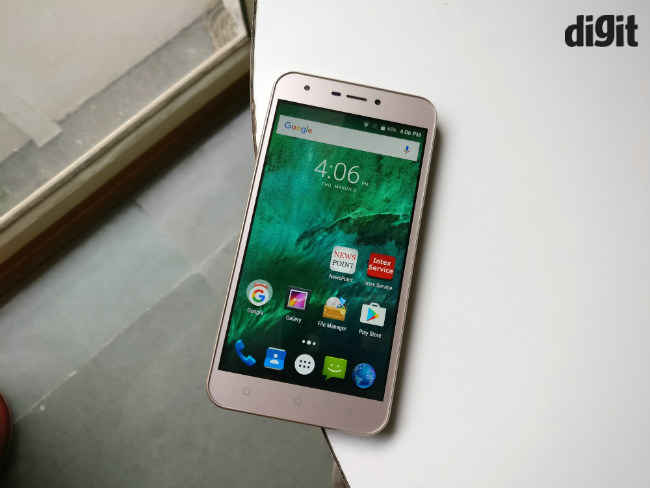
Interestingly, its main feature is the VR capabilities built into it. But, we’ll get to that later. For now, let’s begin with the look and feel.
Build and Design
The design and build quality of the Intex Q11 4G is pedestrian. The glossy back on the phone feels odd and somewhat cheap. It also looks low-end, but seems sturdy enough, considering the price. There’s a certain heft to it and even though the surface looks fragile, it’s not easily scratched, and can withstand an occasional knock or two. Intex does provide an additional clear-case and screen protector in the box, but I believe there’s definitely room for improvement.
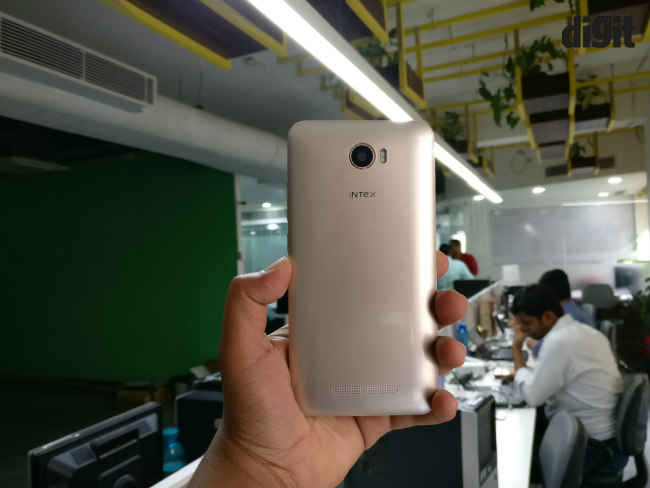
Beside the two physical power and volume rocker keys, there is a silent toggle on the left side of the phone. All three physical keys work as intended, but they don’t respond at times. Also, the buttons feel shallow, as they would if the phone was inside a case.

Also, the phone looks like a carbon copy of the Intex 5.5VR smartphone, which was launched a few months back. The two devices share features as well.
Display and UI
Even the displays on the two devices are the same. The 5.5-inch screen on the phone seems quite good, considering the price. Touch response is wonky, though, it’s more like a hit and miss at times. It works sometimes and at others, takes more than a single tap.
Slow performance makes the sub-par touch performance feel worse, which I shall explain in the performance section. The colour reproduction is quite good, but again, viewing angles are just about average. Sunlight visibility isn't great either and there is a visible colour shift from not so wide angles.
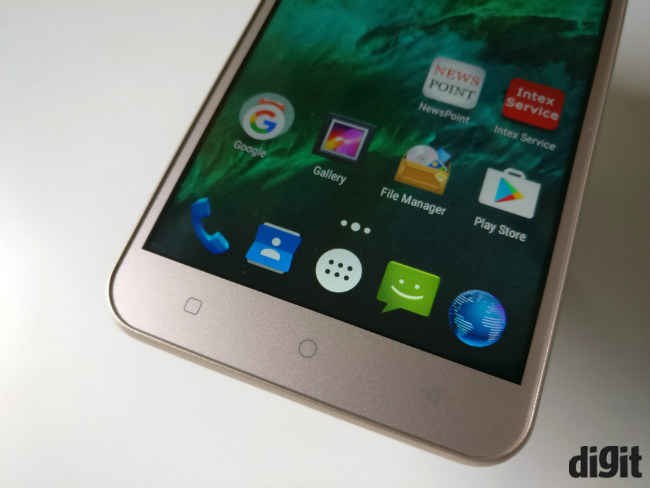
The UI remains the same as well. It bears a stock like facade, which is then integrated into an advert-ridden ecosystem. There are almost a dozen pre-loaded apps, most of which can't be uninstalled. The camera app has shortcuts to a shopping app and editing app. Intex’s own app aggregator will also keep popping up on the device’s notification panel and can be dismissed only after you open it and install a few apps. If you don’t want to, you just have to live with it.
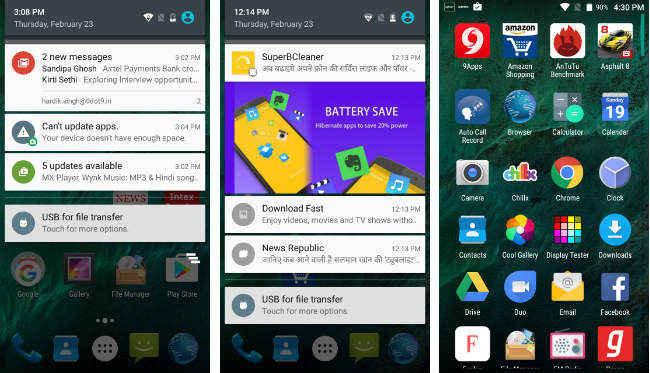
The leftmost homescreen include some weather and current news info from partner apps. While some may like this, and it works as intended, all this together makes it seem like the phone is made primarily to sell apps, rather than providing a good experience.
Performance
The performance of the phone was quite disappointing too. Firstly, there isn’t enough space on, with only 8GB of internal storage. With less than 4GB available to the user, the phone refused to install my regular set of test applications. Further, thanks to Intex’s app aggregator, I ended up installing more unwanted apps, which I then uninstalled.
Interestingly, the phone does not handle apps well either. It lags in simple navigation tasks, like opening recent tabs. This is partly due to the fact that it has only 1GB of RAM and partly because the UI lacks optimisation. It became quite apparent, as simpler games, such as 32 Secs hung a couple of times, when it was the only active task. While the phone does manage to run apps such Facebook, Gmail and Chrome, the experience here is sluggish.
VR is supposed to be a redeeming feature here, and while it does run, it’s not flawless. You can play 360 degree videos via YouTube or watch a pre-loaded videos, but that’s pretty much it. The gyroscope often loses alignment and there isn't much space to install VR games either. Here are some synthetic benchmarks, which do not truly justify the phone’s performance in day-to-day performance.
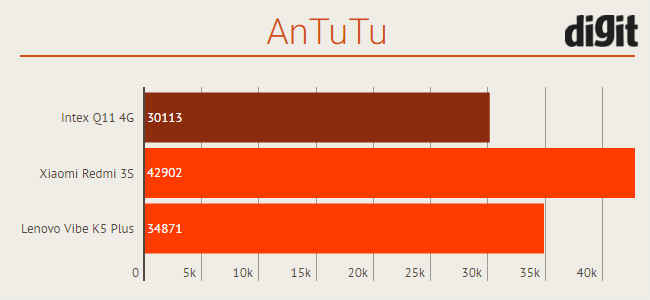
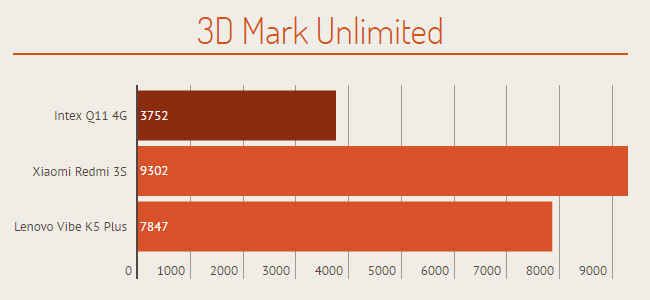
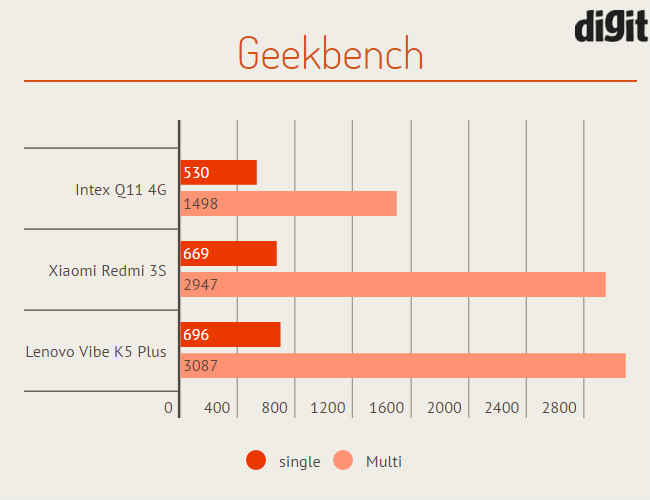
Given its performance otherwise, it’s confounding why Intex wants to sell it on VR capabilities. While lower tier markets may not be privy to things like the Samsung Gear VR (which are not perfect either), this is not the first taste of VR that you should get.
Battery
The PC Mark battery test returns 7 hours and 23 minutes of battery life, which is the industry average today. Using the phone as a daily driver with a Jio SIM, it made it through a normal work-day with over half a dozen calls, about an hour of video streaming, and heavy Facebook and browser usage.
I didn't game much on the device, though, due to unplayable frame rates. Looking past that, there was a drop of 18% in an hour of gaming, with Breakneck.
At one time, while testing the device, it was showing wrong info about the remaining battery percentage. The battery percentage dropped from 30% to 14% suddenly, and then went back up to 35% in the span of less than a minute. This could be an UI issue, or may even be a sign of larger problems. Regardless, it’s not something you want on a phone you just bought.
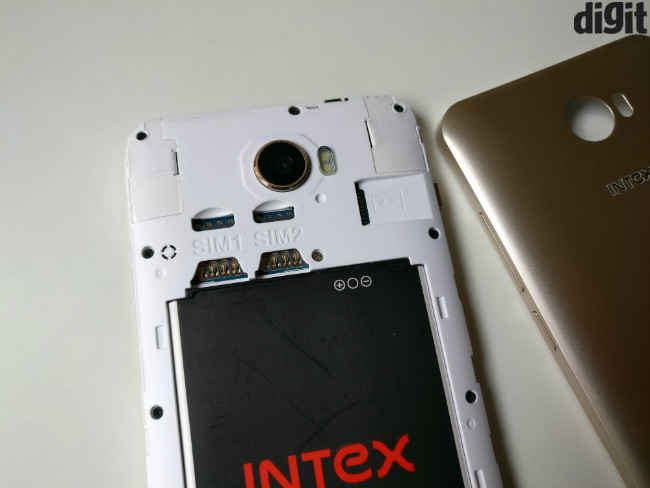
Once discharged, the 2800mAh removable battery takes about 4-5 hours to charge back, which is inconvenient.
Camera
The 8MP rear shooter is again sub-par. Images taken during daytime are dull, lack details and have softer focus, which ruins image all together. Colour reproduction is way off the mark and dynamic range is poor. This also means the camera is unable to process different shades of the same colour properly. As a result, objects lose appeal and pictures lose composure. Image quality further deteriorates as you move indoors and under low light. Under fluorescent light, images appear hazy, with softer focus. Photos are underscored by low details and visible noise. Low light images are almost unusable.
View post on imgur.com
Bottomline
The Intex Q11 4G is a sub-par phone, despite its low price. Its performance is inadequate, the UI is irritating, the camera is unsatisfactory and build quality and design are pedestrian. It’s VR elements aren’t flawless either. I would suggest you raise your budget to about 7K and get the Xiaomi Redmi 3S, which is a much better phone than this.
| Price: |
 Rs. 7800
Rs. 7800
|
| Release Date: | 25 Jan 2017 |
| Variant: | 8GB |
| Market Status: | Launched |
 Screen Size
Screen Size
 Camera
Camera
 Memory
Memory
 Battery
Battery

Light at the top, this odd looking creature lives under the heavy medication of video games.

Digit caters to the largest community of tech buyers, users and enthusiasts in India. The all new Digit in continues the legacy of Thinkdigit.com as one of the largest portals in India committed to technology users and buyers. Digit is also one of the most trusted names when it comes to technology reviews and buying advice and is home to the Digit Test Lab, India's most proficient center for testing and reviewing technology products.

We are about leadership-the 9.9 kind! Building a leading media company out of India.And,grooming new leaders for this promising industry.




न्यूजट्रैक के नए ऐप से खुद को रक्खें लेटेस्ट खबरों से अपडेटेड । हमारा ऐप एंड्राइड प्लेस्टोर से डाउनलोड करने के लिए क्लिक करें - Newstrack App
67
71
71
73
The good looks of the Realme 1 hides the inconsistencies of the phone. It tries to get ahead of the game by gaming the synthetic benchmarks but falls flat in real world performance. It positions itself as a selfie-centric phone but the selfies from the phone comes off as artificial and puffed up.
Oppo has been a player in the Indian smartphone market for quite some time now. The China-based company, owned by BBK Electronics has positioned itself more as a premium brand in the country. Most of Oppo’s offerings have been more or less expensive with a strong emphasis on selfies. One could say Oppo’s offerings are more of a lifestyle device than just a piece of technology. However, the highest demand in the smartphone market in India is for mid-range phones that are low on price and high on features. Oppo wanted a piece of the mid-range cake, but being a premium brand, it can’t just come out with a cheap phone. Hence the brand, Realme. Just like what Xiaomi did with the Redmi brand, Realme wants to do the same for Oppo.
But whether the bet of introducing a new brand will pay off for Oppo or not is fodder for another discussion. The focus right now is whether Realme 1, the first phone under the new sub-brand is an attractive proposition. The phone certainly look different and the diamond black flair adds to the premium charm of it.
The Realme 1 launched in India exclusively to take on the Redmi Note 5 Pro, but how far does it go to settle the argument? We find out.
Design
The Realme 1 looks distinctly different from all other phones at its price, thanks to the diamond-like reflective body. The phone is housed inside a fibre-glass casing that has been cut at different angles such that each section of the glass back turns to a different shade of black when light is reflecting off it. It does look a lot like a diamond. If you like your gadgets shiny and glossy, this phone will catch your eye. The same glossy finish runs along the edges as well.
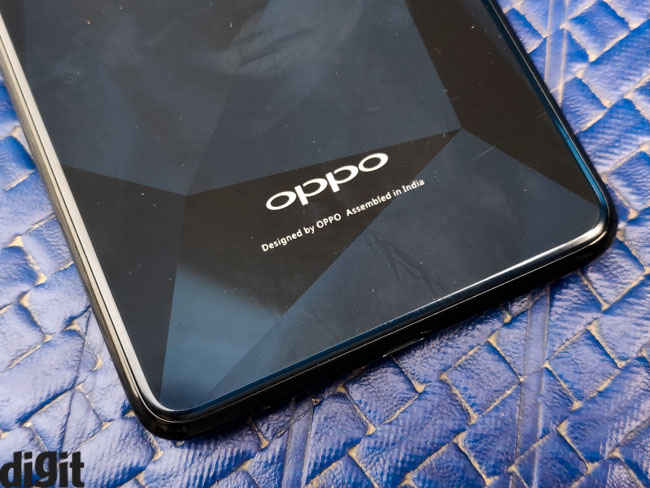
The front is all screen. There are no capacitive navigation button on the front. Even the fingerprint sensor is missing. The Realme 1 relies only on facial recognition for authentication. It’s a brave move by a brand that’s taking its first plunge in a highly competitive market, and other than just being perceived as future forward, it’s actually detrimental to the experience. The user loses out on the reliability of the fingerprint when authenticating purchases. The face unlock is quick, but isn’t reliable enough to keep user’s data secure. You can use facial authentication to access the private space (where you can store apps and data securely), and private apps (that are password-locked). In a practical scenario, the phone was unlocked by a colleague by simply pointing it at my face from a distance.
Apart from the diamond-black finish, it’s a pretty straightforward phone. It rocks the in-vogue univisium form factor and is just 7.8mm thick. There’s an ugly bulge along the edge of the phone that messes with the grip. The screen takes up most of the real-estate up front. The screen-to-body ratio is around 84 percent, which Realme managed to do by fitting the usual 6-inch display in a smaller 6.14-inch frame. The phone is offered in two more colours — Red and silver, but that will be available later in June.
Display
The Realme 1 sports a standard-issue 6-inch Full HD+ display of 18:9 aspect ratio. The panel is just about average with decent colour reproduction. The colour tones are slightly on the cooler side and brightness isn’t high enough to be visible properly when outdoors. In fact, there’s some colour loss at peak brightness and texts appear faded under direct sunlight. The panel quiet reflective too. You get the usual blue-light filters and options to tweak the colour temperature.
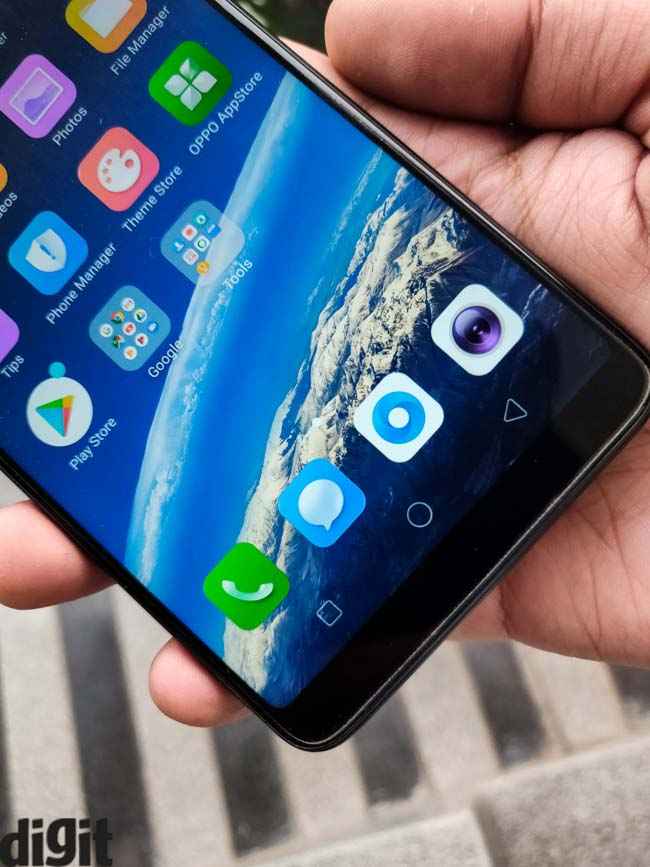
The good part about the panel is that it takes up most of the real estate up front with minimal bezels on the top and the bottom. The sides are also quite thin, which gives off an immersive feel to the content.
Performance and UI
The Realme 1 wants to be the phone of choice for mid-range buyers. The undercutting price point is one instance where it shows. But more than that, it’s the brand’s attempt to beat the best in its maiden attempt that brings out the competitive attitude of the company.
The Realme 1 is powered by the MediaTek Helio P60 SoC which is MediaTek’s most advanced chipset. It comes with an AI chip inside that can compute machine learning tasks on the device itself. It is what powers the facial recognition and the battery efficiency, apart from other things. It’s an octa-core chipset built on a 12nm FinFET process with four Cortex A53 and four Cortex A73 cores, all clocked at 2GHz frequency. On paper it’s faster than its Qualcomm counterpart, as the benchmark results from AnTuTu 7.0 and Geekbench will state. However, when I monitored how the chipset was being used, I observed some anomaly. It seemed for both the benchmark tests, which is comprised of multiple small tasks that stress the CPU to measure performance, the chipset was running at a constant 2.0GHz, irrespective whether the load on the CPU was minimal or at its peak. It could either be an anomaly with the unit I received or Realme is gaming a popular benchmark tests. In a more real world scenario, when the performance was measured while playing the new PubG Mobile game, the CPU speed matched the load put on it. The AnTuTu score for the Realme 1 was 138260 against the Redmi Note 5 Pro’s 112652. The Geekbench Single Core and Multi Core scores are also higher at 1490 and 5682 respectively. But in both cases, the CPU was artificially plonked up to eke out a better score.
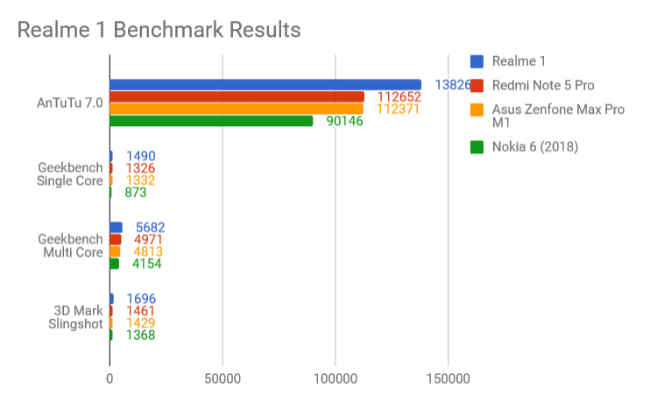
We performed a similar analysis on the Redmi Note 5 Pro which proved to be more consistent in responding to CPU load both during synthetic benchmark tests and real world scenarios. The Realme 1’s anomaly seems a little too deliberative. Nevertheless, there’s 6GB RAM and 128GB storage on the unit we re. It leaves enough resources free despite a heavy user interface. It also support dual VoLTE which is useful in the Indian context.
The Realme 1 relies on Oppo’s Colour OS. It’s definitely functional like all Android-layered user interfaces these days, but I wouldn’t call it particularly appealing. It lacks the attention to detail that MIUI is known or the simplicity of stock Android. Instead, the UI seems cluttered with disproportional icons and overall looks quite cartoonish. It does come with a game mode, a private space and the usual bells and whistles of Android Oreo, but that doesn’t take away the fact how uninviting the UI looks for a nitpicking user.
Camera
The fate of smartphones these days is decided by how good the camera is. The Realme 1, in that section, is quite underwhelming in comparison to the competition. It has a single 13-megapixel sensor at the back while on the front is an 8-megapixel shooter. The focus, unsurprisingly, is on selfies and portrait shots. The phone relies on Oppo’s AI algorithms to fine-tune the photos which the company claims works by analysing 296 recognition points to understand the skin tone, age, gender, etc. Based on that analysis, the phone applies one of 8 million ‘beauty solutions’ to the image.
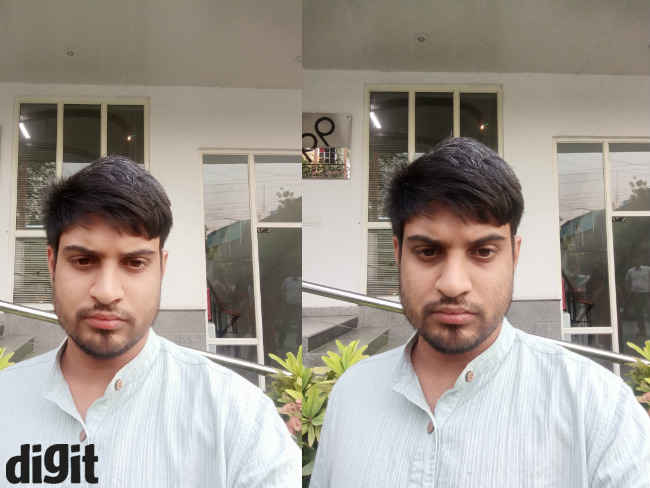
The end result is simply a photo with extreme layers of softening, so much so, that all spots and blemishes are hidden. It was a tad difficult for me to accept the effects, but I suppose there’s a demand for them in a country where fairness creams are one of the highest selling products. If beautification is what you’re seeking from a smartphone camera, the Realme 1 will be a pure delight. But if you’re a little more serious about taking good photos, the phone might leave you hanging.
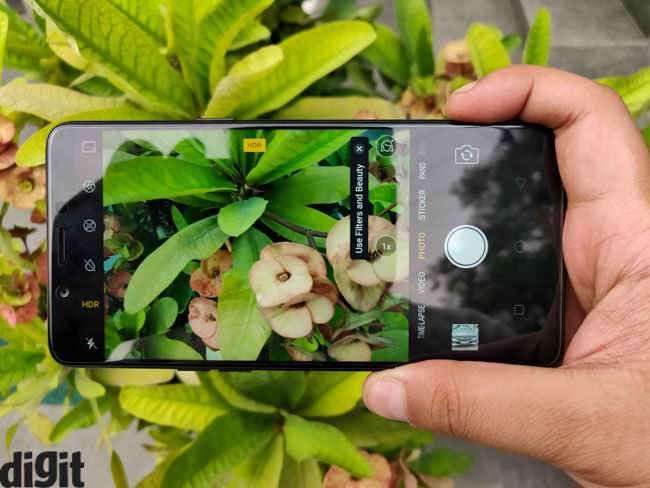
In daylight, the photos have ample highlight clipping. There’s practically no detail in the bright sky in the photo below. Furthermore, the camera tends to saturate the colours more than they are in reality. It also lacks the desired dynamic range.
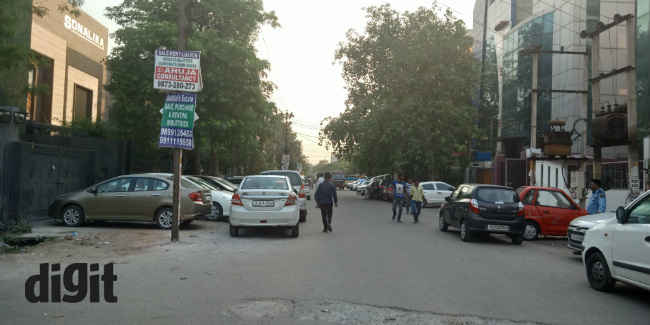
Indoor shots are a little more polished. The controlled light brings out the good side of the camera. There’s more controlled AI enhancement and the little that it does, it makes objects look much better than they are in real. You get good sharp images with a slightly warmer white balance. There’s some glare off the source of light though, which might be a lens issue.
Under low light, the camera fails to show much promise. Grains show up if you try to dial the exposure higher to take an image under poor lighting, with little to no detail. The shutter speed is actually dialled up when there’s less light which demands a steady hand and if the object is moving, you get a blurred photo.
The portrait mode is present both on the front and the back camera. The Realme 1 relies on software to simulate the depth-of-field effect. It’s nowhere as consistent as the Redmi Note 5 Pro, but it does the job as far as blurring the background is concerned.

Battery
The Realme 1 is powered by a 3410mAh battery. For those comparing, that’s a hairline more than what Xiaomi’s best mid-range phone offers, and the battery life of the phone is more or less at par. The phone managed to run for 6 hours on the PCMark Battery 2.0 Test which should easily convert to over a day’s usage for an average user. For the review, I used the phone to browse the internet, play games, take photos and use social media. It did last me for a typical work day and then some more. The Helio P60 chipset seems to be quite energy-efficient and based on the battery life, Realme seems to be delivering on its promise of using machine learning to manage resources. The battery section in the Settings app gives some insight in how much juice each app takes and apart from the resource-intensive game I was playing, the UI sucked up most of the battery. When you are running out of power on this phone, you know what to blame.
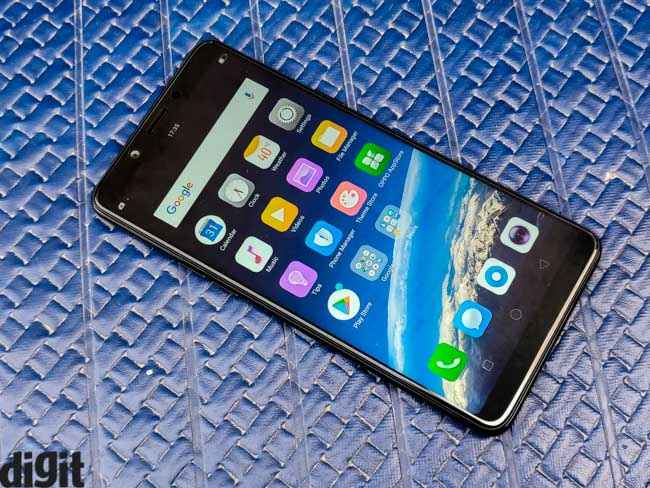
Bottomline
The debutante Realme 1’s ambition to compete with the likes of Xiaomi Redmi Note 5 Pro is quite apparent. It looks boldly different from the rest, but a good design will only take it so far. The performance is nowhere near the best in the market, despite the benchmark results telling you so. The camera which is propped up by on-device machine learning ends up delivering unnaturally softened photos while the UI comes off quite amateurish. The battery life is the only saving grace, but overall this phone isn’t what it advertises to be. Oppo’s decision to come out with a new sub-brand to cater to the highly competitive mid-range market may be driven by consumer demand, but there’s little in the phone to entice buyers, apart from a good looking device.
| Price: |
 Rs. 10999
Rs. 10999
|
| Release Date: | 25 May 2018 |
| Variant: | 32GB , 64GB , 128GB |
| Market Status: | Launched |
 Screen Size
Screen Size
 Camera
Camera
 Memory
Memory
 Battery
Battery

Digit caters to the largest community of tech buyers, users and enthusiasts in India. The all new Digit in continues the legacy of Thinkdigit.com as one of the largest portals in India committed to technology users and buyers. Digit is also one of the most trusted names when it comes to technology reviews and buying advice and is home to the Digit Test Lab, India's most proficient center for testing and reviewing technology products.

We are about leadership-the 9.9 kind! Building a leading media company out of India.And,grooming new leaders for this promising industry.


Raj Kapoor with his granddaughters
Bollywood actress Kareena Kapoor Khan took to social media to share an unseen throwback picture from her and Riddhima Kapoor Sahni's childhood with grandpa Raj Kapoor as Riddhima turned 40 on September 15. Sharing the picture, she wrote, “Sister sledge. Happy birthday beautiful Ridz @riddhimakapoorsahniofficial (sic).”
In the picture, little Bebo and Riddhima can be seen sitting in grandpa Raj Kapoor’s lap while Karisma can be seen hugging him. As the picture refresh their childhood memories, Riddhima was quick to drop a comment to Bebo’s post and wrote, “Aww thank you Bebo. @KareenaKapoorKhan love you (sic)."
This adorable throwback picture gives a glimpse of sisters’ strong bond that they have been sharing since their childhood. Karisma also reposted the same picture with a witty caption. She wrote, ”Bebo can you please wake up? Oh that goes for me too #family #Repost (sic).”
The actress also shared a couple of photos with Riddhima on Instagram and wrote, "Happy 40th birthday! so glad we got to celebrate with you! @riddhimakapoorsahniofficial #birthdaywishes #family #cousins #happybirthday #familytime (sic)."
Karisma and Kareena also shared pictures from the celebration on their Instagram stories. The Kapoors gathered at Neetu Kapoor’s house to celebrate Riddhima’s 40th birthday. Bebo’s husband Saif Ali Khan and Ranbir Kapoor’s girlfriend Alia Bhatt also joined the celebration.
Riddhima is showered with love and best wishes from family and friends. Several other Bollywood celebs also took to social media to wish the birthday girl.
Meanwhile, Bebo is also gearing up for her 40th birthday in the coming week on September 21. It seems like this month is going to be the birthday month for Kapoors.

File image of Kim Kardashian.
As much as we love Facebook and Instagram for connecting us with our favourite actors and influencers, we cannot ignore the fact that the social media has been giving a platform to hate speech and misinformation also. To urge Facebook to reform its policies against hate speech, celebrities like Kim Kardashian, Jennifer Lawrence and others are going to quit social media for a day under the #StopHateForProfit campaign.
Facebook ignores hate & disinformation on their site. This is not an “operational mistake.” It is a deliberate decision to put profits over people and democracy. Tell Facebook to #StopHateForProfit. https://t.co/7TSovLMug2 pic.twitter.com/lJts6Ampgp
— Jennifer Lawrence - Represent.Us (@JLawrence_RepUs) September 14, 2020
Actors like Sacha Baron Cohen have joined forces with the Anti-Defamation League (ADL) to launch the campaign calling on Facebook to crack down on hate speech, violence, and misinformation on its platforms. In one of its recent tweets, ADL said, “Facebook does not protect its users from hate or disinformation. Facebook has shown us time & time again that profits come before people. That’s why we are “freezing” our Instagram account for 24 hours.”
The only thing more terrifying than Mark Zuckerberg surfing in whiteface...Is the white supremacy and lies Facebook spreads every day. This Weds Sept 16 I’m freezing my Instagram to tell Mark to #StopHateForProfit. Who’s in?! pic.twitter.com/nM5VB9YVZd
— Sacha Baron Cohen (@SachaBaronCohen) September 14, 2020
Facebook does not protect its users from hate or disinformation. Facebook has shown us time & time again that profits come before people. That’s why we are “freezing” our Instagram account for 24 hours.Join us & send a message to Facebook to #StopHateForProfit. pic.twitter.com/84n9dAx9WB
— ADL (@ADL) September 16, 2020
The "freeze" is part of the campaign’s "week of action”, which kicked off Monday. Members plan to continue to share information on "how Facebook’s failures lead to real-life violence and sow division" and call for change through the end of the week.
Businesswoman and social media influencer Kim Kardashian also urged Facebook to stop providing platform to hate speech which is dividing America. She tweeted, “I can’t sit by and stay silent while these platforms continue to allow the spreading of hate, propaganda and misinformation - created by groups to sow division and split America apart only to take steps after people are killed. Misinformation shared on social media has a serious impact on our elections and undermines our democracy.”
I love that I can connect directly with you through Instagram and Facebook, but I can’t sit by and stay silent while these platforms continue to allow the spreading of hate, propaganda and misinformation - created by groups to sow division and split America apart pic.twitter.com/XkxzABn7qw
— Kim Kardashian West (@KimKardashian) September 15, 2020
Actor Mark Ruffalo has also called on Facebook to take substantial steps to stop hate speech, misinformation on its platform and has frozen his accounts this Wednesday.
Facebook claims they address hate, yet they continue to look the other way as racist, violent groups and posts sow division and split America apart – only taking steps after people are killed. (1/2) pic.twitter.com/AfO70nEEo8
— Mark Ruffalo (@MarkRuffalo) September 14, 2020
Thank you to @michaelb4jordan @iamjamiefoxx @LeoDiCaprio @kerrywashington @KimKardashian @NaomiCampbell for calling out Facebook for ignoring hate & disinformation on their site. This is not an “operational mistake.” It is a deliberate decision to divide.#StopHateForProfit pic.twitter.com/lI1P5kQus6
— NAACP (@NAACP) September 16, 2020
With the US Presidential elections just a month away, social media platforms have become an essential platform for politicians and other interest groups to target its voters and influence the election results. The political scene in the United States has been polarised since President Donald Trump took office with some help from Facebook as explained by Netflix documentary The Great Hack. The recent Black Lives Matter protests and President Trump’s ways of curbing it have only raised questions on social media companies' responsibility in tackling fake news which can endanger marginalised people’s lives.
India 500
Worldwide 10000
India 1500
Worldwide 60000
India 9000
Worldwide 89000
Rimini Street Statement on Court Ruling on Motions for Partial Summary Judgment
Rocking Superstar, YASH Picks EXCEED Entertainment for Bollywood Representation
Power Integrations Targets Compact Smart-Lighting Designs With Highly Efficient GaN-Powered LYTSwitch-6 LED Drivers
Alibaba Unveils New Manufacturing Digital Factory
Bentley Systems Announces Launch of Initial Public Offering
New Optimum® Class VI Dispensing Components Provide Assurance to Medical Manufactures
For quite some time, a piece of news showing India has 21 million jobless has triggered fear in the minds of those who still retain their purse. Those who lost their salaries have blamed it on the prevailing pandemic. But when the virus was absent, a strange activism had prevailed across India, ensuring some of the largest businesses remained shut across the country, and some of the Indian companies working abroad drew flak.
Jobless workers protest in Goa to reopen iron ore mines
So let’s take a quick look.
Work has stopped in the iron ore mines in Goa, one of Asia’s largest copper plants has shut down in Thoothukudi in Tamil Nadu, troubles are brewing in iron ore mines in Chhattisgarh and Odisha and at the Adani group’s coal mines in the Down Under. Strangely, these have become disturbing symbols of the Indian industry.
All has come at a cost to the economy, imports have increased and exports taken a tumble.
At the heart of this are protests by a handful who have hopped, skipped and jumped from one protest to another, ensuring they generate the much needed steam to their movement. One movement has died, another risen like the proverbial Phoenix from the ashes. These activists have routinely raised India’s big issue of land versus machines and cried wolf, smoking out everything else from the horizon. They are not worried about a lakh of miners going jobless and hungry for over two years in Goa. They do not care about 35,000 struggling without salaries in Thoothukudi, or, for that matter, Indian companies piling up huge non performing assets in the mines of Chhattisgarh, Odisha and Jharkhand. Like Bengal’s ubiqutious Cholbey Na slogan in the 70s that killed industry in that eastern Indian state, these activists have continued their activism for a very long period.
What is surprising is their claim to fight for people’s rights when these rights are actually nowhere in sight. There is a common thread of people who are omnipresent in all these protests, their frustration seems both natural and common. They want the world to believe that India is burning, Indian companies are dubious, the world’s second most populous nation is in a revolutionary mood.
Last week, a Dubai-based activist campaigning against Adani’s coal mines in Australia, mistakenly revealed how he planned to scuttle Adani’s operations through an email that got leaked. In the email, the activist had apprised his friends in Australia about his plans to set up a website and create trouble for the Ahmedabad-based Indian conglomerate which runs business ranging from infrastructure to airports to ports to edible oil.
The activist’s Dubai to Australia connection to discredit an Indian company is interesting, especially at a time when jobs are at a premium and a closure would mean further catastrophe. The activist was seeking help from an anti-Adani group in Australia. Helping him were activists in India who have been in the forefront of the anti-Sterlite movement in Tamil Nadu, and against mining companies in Odisha, Jharkhand and Chhattisgarh.
Iron ore, coal and copper do not jell together but the broad idea was to add an Indian twist to build up a narrative of alleged wrongdoings in India and get it amplified in Australia. Or, for that matter, across the world. Recently, these activists raised another hue and cry over India’s coal mining and argued why it could not be substituted by solar or wind energy. Little did they realise that coal – under any circumstances – could not be replaced overnight, it still remains the best possible resource for energy in a billion plus nation. Conspiring activists are challenging the energy security of the country where per capita electricity consumption is just about 1200 units a year compared to China with four to five times higher numbers.
Those criticising India and its energy policies forget the developed nations have per capita electricity consumption is as high as 10000 to 20000 units. Little did they care that their misplaced activism could affect the Indian economy, disrupt growth opportunities & reduce scope of employment badly. They did not care that projecting one conglomerate with negativity would diminish another Indian conglomerate’s chance for inter-continental projects Indian companies are eyeing in a post-Covid situation. They seem to be keen on building an overall negative perception globally that Indian corporates care little for environment and human rights and also the rights of tribals and indigenous peoples. They do it knowing very well that their actions would help create an anti-Modi sentiment across the Indian borders.
What is interesting is that the majority of these protests are against large private firms and happening in a selective manner. For instance, Adani Group does not own any mine in India and it is a contractor for state owned mines. However, all energy and attention of so called activists is targeted to a contractor producing 15 million tonne a year for a state utility instead of the world’s largest coal mining firm, the Kolkata-based Coal India Limited (CIL) just because it is a public sector undertaking. The big race for breaking headlines in India often misses the real picture.
Surprisingly, none of these environmental activists ever hit the print industry that also claim millions of trees to produce newspapers. Worse, industries in India have often expressed their concerns over blackmailing by activists by misusing or manipulating media.
So let’s take a look at the protests against Adani. There is a peculiar pattern spotted in protests against the likes of Adani where Indian activist lobby is supporting protests in Australia, which is the world’s largest coal exporter with well over 25 percent market share. Indian activists have never expressed concerns against CIL or other Australian mining entities. Singling out one from a cluttered market creates suspicion. It would not be wrong to say interests of Australian activists started in Carmichael mine generated only after it was acquired by Adani from an Australian mining entity.
So why is this happening?
There is some deep-rooted economics of this activism. If there are Cola giants, they need to be linked to water crisis (never mind if the demand to ban the soft drink majors comes from faraway Norway), if there is iron ore or coal, the mining companies need to be blamed and if there are airports and ports, infrastructure giants need to be hauled over the coals. On paper, these activists lace their work with a tinge of environmental activism. It is all about some interesting twists and turns, it is about deferring current consumption for a better and secure tomorrow. They tell the world that if companies pollute rivers and cut forests for mining, the coming generations will get nothing on plate.
That is a great argument, a great platform for breaking news that is considered both dangerous and madness by many in South Asia. The world loves visuals of an impoverished tribal standing tall with his father’s machet against miners seeking to break the earth for iron ore, or coal. It is a great photograph of protest, students love to flaunt it to their parents, and friends. It is the best form of defence, there is no economics of scale involved.
But these self-styled mass movements for environmental causes actually come packaged without a reason. It is like asking the poor – who is at the rock bottom of the economic ladder – to kill industry and defer consumption. In most cases the poor back out, and these movements die a silent death.
A serious look at activism in India will show an interesting trend. Ever since the Supreme Court gave approval in October 2020 to the Sardar Sarovar Dam project in Gujarat, activists shifted their gears in favour of rights, ranging from land, homes, food, information and health. They did not care, did not realise that a nation’s resources are best saved when the government blends a lot of economics in its decisions and achieves a balance. They should have taken a lesson or two in economics from India’s lost decade (2004-14) before hyperventilating on corporate greed.
The need of the hour is to generate jobs, not protests. Activism must be laced with realism. Else, the jobless will spill out on the streets. And that would be dangerous for the nation, and its economy.
82
87
63
74
With the Galaxy Note 5, Samsung has completed the transformation it started with the Galaxy S6 this year. The phone is a combination of power and design, and not many would deny that the phone looks good and performs well. It’s pure style, combined with good performance. The only real hitch is that a phone this expensive shouldn’t be prone to falling out of your hand. If you’re looking for a flagship phablet, then this is still the one to buy though.
Having reviewed three out of four Samsung flagships this years, there’s not much left to say about the Galaxy Note 5 that we haven’t said in those other reviews already. What differs though is that The Samsung Galaxy Note 5 has much more to live up to than the other devices. This is a segment that Samsung pioneered, which means that the responsibility of innovating falls on its shoulders. Evidently though, the company’s focus this year is on design, because that’s precisely where the Note 5 is different from other Note devices till now.
Build and Design
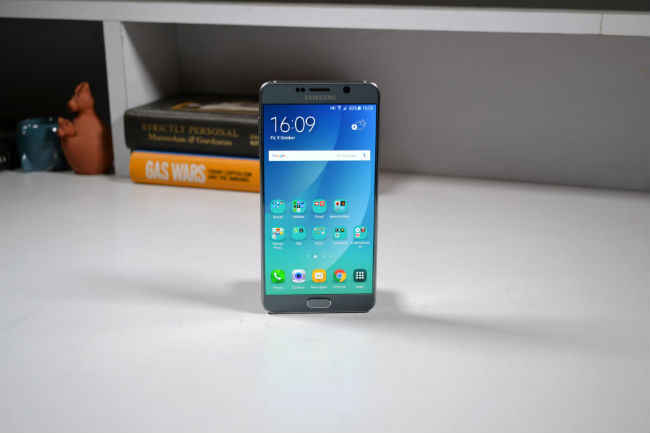
The glass and metal design philosophy that Samsung adopted for its flagships, continues with the Note 5. The phone has curved glass on the back and a sheet of Gorilla Glass 4 on the front. But you already know about that.
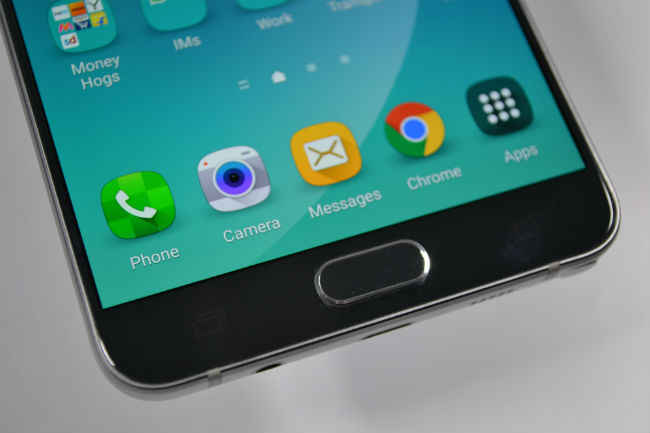
What you need to know is that while the Note 5, like the Note 4 before it, is more compact than other phones in this series, it remains unwieldy. Many seem to like this large size though, so the decision falls on the buyer. The heavy usage of glass though makes the phone really slippery and prone to falling out of your hand.
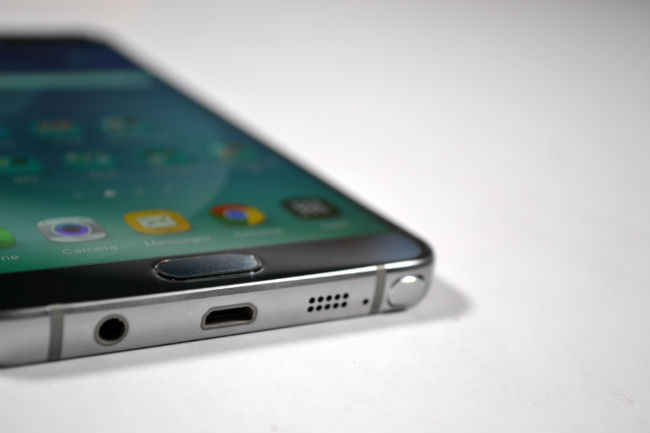
None of that changes the fact that the phone looks premium though. The curved glass on the back has but one job, and that is to make this phone look good and different. From the front though, it’s a quintessential Samsung design, and whether you like it is completely your own opinion. For us, we would give Note 5 a lot of marks on the looks front.
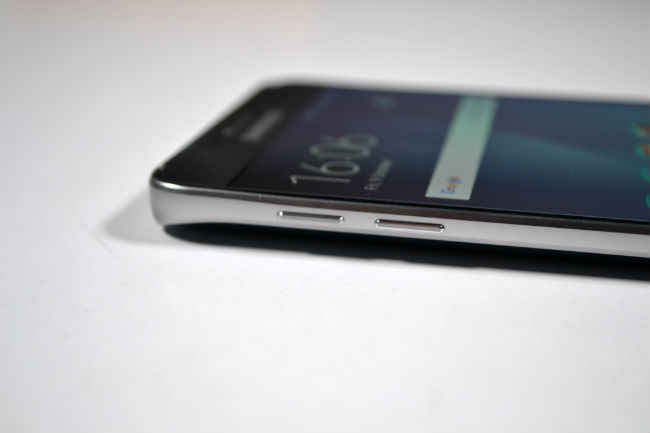
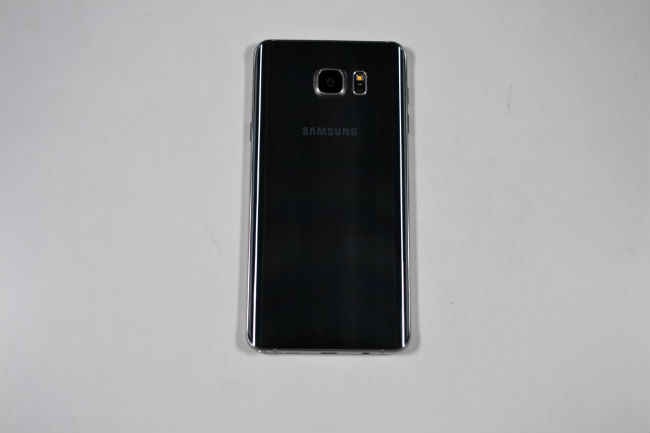
Display
If you’ve read out Galaxy S6 Edge Plus review, you already know how good the Note 5’s display is. The 5.7 inch QHD SAMOLED display is one of the best out there. What’s interesting is that Samsung has toned down the yellowish-ness of the display. The Galaxy S6 Edge has a pretty warm display, to the point that it looks like the odd one out when placed next to an LG G4 and Sony Xperia Z3+, but the Note 5’s display is not as warm as we’ve come to expect from Samsung.
Colours are really vivid on the display, and if you’ve liked Samsung displays till now, this one’s to die for, just like the S6 Edge Plus.
Watch Video
S-Pen
The S-Pen on the Galaxy Note 5 is as good as it ever was, and a tad better. That said, even with a 5.7 inch display, there's only that much that you can do. If you've been a big proponent of Samsung's S-Pen though, then the one on the Note 5 is easily the best till now. It writes almost like a real pen and Samsung has added the option to add apps to the Air Command menu. So, you can now add apps like Evernote, OneNote and others to the Air Command menu and write on them using the S-Pen. What's more useful though is the Screen Off Memo option, which allows you to write with the S-Pen even with the display turned off. Whenever you pull the S-Pen out of the Note 5, the screen will remain black, but you can write on it and jot down a few notes. It's limited in the sense that there's only that much you can write on a 5.7 inch display, but its pretty useful nevertheless.
Lastly, and perhaps most importantly, the Galaxy Note 5 can alert you if you've left the S-Pen behind somewhere. This perhaps is something that every Note user would appreciate, considering how many have lost their styluses. The S-Pen Alerts option is turned on by default and you can turn it off from the Settings menu.
Performance
Benchmarks don’t ever suffice for performance testing, but Samsung’s got both the aspects covered with its Exynos 7 Octa processor. This is the same processor that runs on the Galaxy S6, S6 Edge and the S6 Edge Plus.
In regular usage, the Galaxy Note 5 can take anything you throw at it, and the bigger size of the phone, allows for better heat circulation, allowing the average clock speed to remain higher than in the Galaxy S6 and S6 Edge. The performance of the phone can’t be credited to the SoC alone though. While Exynos 7 is a good processor, the Note 5’s performance owes a lot to the fact that Samsung has made no compromise. The sequential read speeds for the storage on the phone come to around 440 MB per second which for the general public, translates to really good. In addition, DDR4 RAM allows the performance to be even smoother, and 4 GB of it, allows for a lot of multitasking.
The overall performance of the Note 5 is a combination of processor, NAND and RAM, and they all do well working in unison. It’s the best performing Android phone in the market right now, speaking in terms of pure performance. Even the call and network performance on the Note 5 is better than others. In a room with 5 people on the same Vodafone network, the Note 5 can get a 3G signal even when others are stuck on Edge. This is something that many iPhone users report about their devices.
It would be worth mentioning that the Galaxy Note 5 sends diagnostic reports to Samsung servers whenever it's connected to a WiFi. You can turn this off from the Settings Menu, by going into Lock Screen and Security. I have contacted Samsung to clarify that the Reports are indeed only diagnostic reports, and am yet to hear back from it.
Battery
All the performance though, usually take a toll on the battery life, so when Samsung allowed a 3,000 mAh battery, I was somewhat disappointed. You’re talking about a 5.7 inch QHD display here, along with a powerful octa-core processor.
Here again though, the Note 5 exceeded expectations. On a regular work day, with exactly 26 phone calls, lots of IMs, social networking and about 20 minutes of gaming, at midnight, the phone had 15% of battery left. This is without using the battery saver mode at all, and that’s about as good as any phone in the market can give you today.
Camera
We’ve discussed Samsung’s prowess with cameras in the Galaxy S6 Edge and S6 Edge Plus review, so we’ll simply direct you to those for this one.
Bottomline
With the Galaxy Note 5, Samsung has completed the transformation it started with the Galaxy S6 this year. The phone is a combination of power and design, and not many would deny that the phone looks good and performs well. It’s pure style, combined with good performance. The only real hitch is that a phone this expensive shouldn’t be prone to falling out of your hand. If you’re looking for a flagship phablet, then this is still the one to buy though.
| Price: |
 Rs. 29999
Rs. 29999
|
| Release Date: | 15 May 2017 |
| Variant: | 32GB |
| Market Status: | Launched |
 Screen Size
Screen Size
 Camera
Camera
 Memory
Memory
 Battery
Battery

Digit caters to the largest community of tech buyers, users and enthusiasts in India. The all new Digit in continues the legacy of Thinkdigit.com as one of the largest portals in India committed to technology users and buyers. Digit is also one of the most trusted names when it comes to technology reviews and buying advice and is home to the Digit Test Lab, India's most proficient center for testing and reviewing technology products.

We are about leadership-the 9.9 kind! Building a leading media company out of India.And,grooming new leaders for this promising industry.
